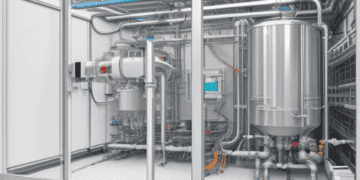In the field of manufacturing, particularly in processes involving surface coating like electroplating, automation is playing an increasingly crucial role. A notable example of this trend is the introduction of a robot cell developed for fully automated electroplating, significantly benefiting Roth Technik, a Swiss automation firm. This development is a product of a collaborative effort involving the customer, Collini—a surface coating specialist based in Dubendorf, near Zurich—alongside Roth Technik and sensor technology expert BAUMER.
The collaboration was driven by the need for a compact system capable of efficiently preparing small parts for electroplating, a challenge underscored by the limited space available for the operation. “The area allocated for stacking boxes of small metal parts was extremely constrained, making the manual process of loading parts onto racks for electroplating highly impractical,” Marco Fuchs, Head of Product Engineering at Collini, explained. The traditional manual method, which requires considerable space and manpower, prompted the search for an automated solution.
The partnership between Collini, Roth Technik, and BAUMER led to the creation of a fully automatic, space-efficient loading line. Central to this line are four robots tasked with precisely hanging parts on electroplating racks, a process complicated by the variability in rack designs and the condition of the hooks.
The challenge of ensuring accurate positioning of parts on the racks was met with a solution from BAUMER—the OXM200 profile sensor. This ultra-compact sensor, mounted on the robot arm, identifies the exact position of each hook, allowing the robot to adjust and place each part accurately. “The sensor’s performance is critical; it must detect thin hooks in three dimensions with high precision,” Markus Roth, CEO of Roth Technik, stated. After evaluating various systems, the OXM200 was chosen for its precision, compact design, and efficiency in object detection.
An additional benefit of the OXM200 sensor is its direct output of measured values in millimeters for both X and Z coordinates, streamlining the control process and expediting project completion. The sensor’s Power over Ethernet (PoE) capability simplifies connectivity and power supply, an important consideration for sensors mounted on mobile robot arms.
This automation solution, requiring minimal space, has effectively replaced the manual loading process, demonstrating the potential for two robot cells to handle a throughput of 15 million parts annually. This case study not only highlights the successful application of automation in overcoming spatial and operational challenges but also illustrates the potential for collaborative innovation in enhancing manufacturing efficiency.
Catch the latest in supply chain news on The Supply Chain Report. Visit ADAMftd.com for free international trade tools.
#AutomatedElectroplating #ManufacturingAutomation #SurfaceCoating #ElectroplatingSolutions #SwissAutomation #RobotCell #CompactAutomation #RothTechnik #Collini #BAUMERSensors #OXM200 #IndustrialInnovation #SensorTechnology #AutomationEfficiency #SmartManufacturing

















